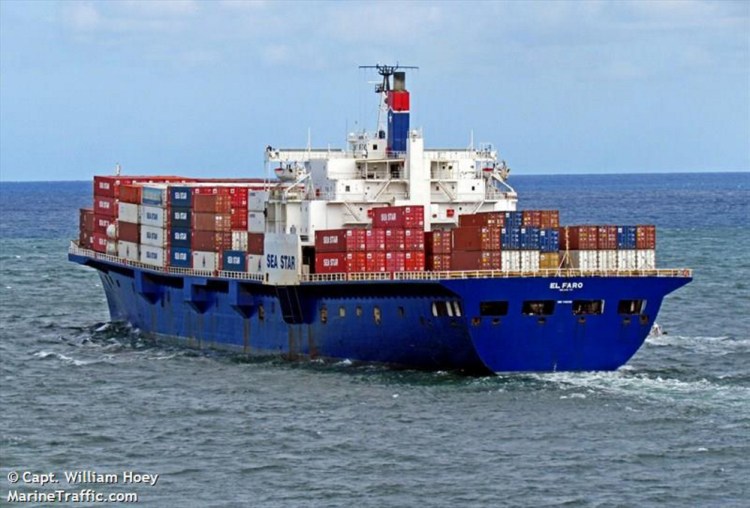Some naval architects say El Faro’s design and cargo configuration could have played a role in its sinking.
The 40-year-old ship wasn’t a conventional container ship, but a “roll-on/roll-off” cargo vessel designed to carry trucks and other vehicles that are driven on and off the ship. When the El Faro departed Jacksonville, Florida, last Tuesday bound for Puerto Rico, it was carrying 294 cars, trucks and trailers below deck, as well as 391 containers on its top deck.
The El Faro, which one naval architect said was more than a decade older than the 25-year design lifespan of merchant vessels, was due to be replaced on the Puerto Rico route by a new ship later this year or early next year.
TOTE Services of Puerto Rico, the company that owns the El Faro, said the vessel was sound, well-maintained and passed its annual Coast Guard inspection in March.
Roll-on/roll-off ships have large external doors close to the waterline and open vehicle decks with few internal compartments. The El Faro had vehicle doors on the side of the hull rather than the bow and stern.
During extreme weather, such as the 30- to 40-foot waves the El Faro encountered as it approached the eye of Hurricane Joaquin near the Bahamas on Thursday, sea water can pour through an improperly secured or damaged loading door, said Richard Burke, professor of naval architecture and marine engineering at the State University of New York Maritime College.
Such ships require large open spaces, like the hangar decks on aircraft carriers, he said, and when water gets inside, it will “slosh” around the entire deck, making the ship unstable, he said.
This sloshing is known as the “free surface effect,” and a surprisingly small amount of water can cause a ship to capsize, said Rick Spilman, who has worked as a naval architect for 30 years and writes a blog about ships.
That’s why critics of the design call ships like the El Faro “roll on/roll over” ships.
In 1987, when a bow door was left open on the passenger ferry MS Herald of Free Enterprise as it left dock in Belgium, water on the vehicle deck caused the ship to capsize in 90 seconds, Spilman said.
In 2006, a fire broke out on the Egyptian ferry MS al-Salam Boccaccio 98. Water from fighting the fire collected on the vehicle deck and caused the ship to capsize and sink with the loss of over 1,000 lives.
Spilman said roll-on/roll-off ships are popular for the route between Florida and Puerto Rico because they provide an efficient way to move cargo short distances, and there’s a large volume of vehicles shipped on the route.
However, he said roll-on/roll-off ships are less safe than conventional container ships because they are much more likely to flip over.
When a conventional container ship is in rough weather, he said, containers can tumble off the deck and lower the ship’s center of gravity, making the ship more stable because the containers inside the hold are more likely to remain secure than something that has been driven on. A conventional ship is more likely to sink slowly rather than capsize, giving the crew time to escape in life rafts, he said.
The crew of the El Faro reported Thursday morning that the ship had lost propulsion and some water had entered through a hatch that had popped open. The ship was listing 15 degrees. Radio contact went dead at 7:20 a.m.
‘PRELUDE TO DISASTER’
The ship’s emergency beacon sent out a signal briefly and then stopped. The beacon is designed to float away from the ship and continue sending a signal.
If the El Faro had capsized, the beacon could have been trapped underneath the ship, Spilman said.
“It appears that something very sudden happened,” he said.
In addition to the sloshing water in the trailer deck, trucks can become unsecured in heavy seas and slide to one side, causing the ship to list even more. That’s what happened when the Korean ferry Sewol capsized in 2014.
“Once cargo starts breaking loose, very bad things start to happen,” Burke said.
If water got into the El Faro’s hold it also could have affected its fuel-oil fired steam engine. Once a ship loses power, it loses maneuverability and waves will begin crashing into the ship broadside, causing it to roll violently. “Losing the power is often the prelude to disaster,” Burke said.
He said the age of the El Faro, built in 1974, also may be a factor. Cargo ships are usually designed to last 20 to 25 years, although older ships often operate on shorter routes, Burke said. He added that old ships are like old houses in that they need more maintenance.
The company had planned to replace the El Faro with a new ship, either later this year or next spring, and put the El Faro back to service in Alaska after being refitted and updated. From 1993 to 2003, the ship, then called the Northern Lights, carried cargo between Tacoma, Washington, and Anchorage, Alaska.
The San Diego shipbuilder NASSCO is now in the final construction stages of building two new container ships for TOTE. Both will be powered by natural gas and operate between Jacksonville and Puerto Rico for the TOTE subsidiary Sea Star Line.
Both of the new ships will be conventional container ships.
Send questions/comments to the editors.



Comments are no longer available on this story